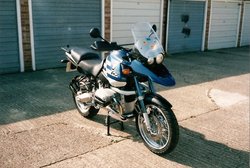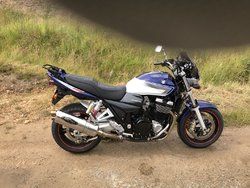- Local time
- Today, 07:39
- Joined
- Jan 5, 2006
- Messages
- 54,115
- Points
- 1,327
- First Name
- Dave
- My Ride
- Speedmaster
- Riding Since
- 1974
Published in: Bikes
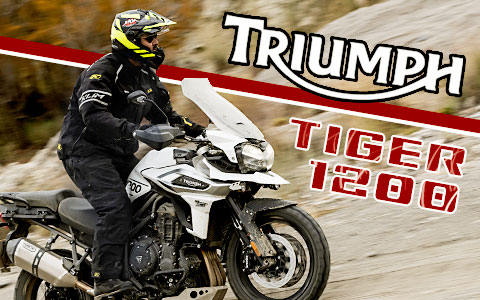
Having shed the Explorer moniker, Triumph ushers in a new era for their flagship adventure bike with the 2018 Tiger 1200. Changing a name, like simply updating graphics or colors, can mean anything. Visual updates aside, does this big Tiger have more bite or just new stripes? ADVMoto travels to beautiful Almeria, Spain to find out.
https://www.youtube.com/watch?v=6ou-4dkxDn0
• Power and Performance
Power is almost never a problem when it comes to modern 1200cc class bikes. Although they tend to be heavy, there's plenty of torque on hand to get you out of most low speed situations and cruise comfortably at highway speeds. The big difference isn't only the sheer power, but how it's managed and delivered.
Triumph made several updates to the three-cylinder power plant which saw a slight increase to 141hp near its 10,000RPM redline. With 90ft-lbs (at 7,600RPM) on tap, the 1,215 triple moves the claimed 546lbs dry weight well enough, especially when you get the motor singing at the top end of its nearly linear horse power delivery.
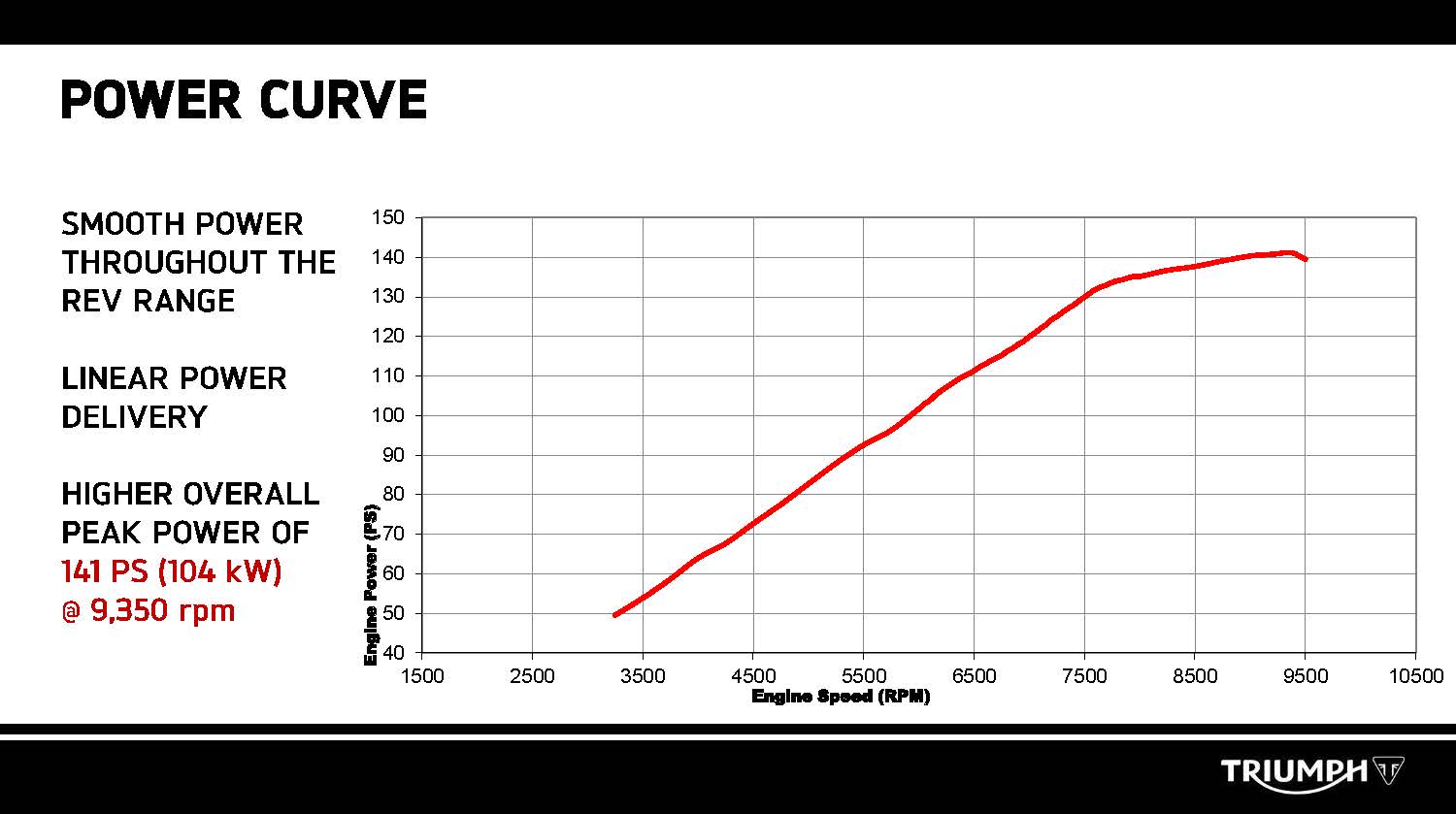
One rider said throttle response almost felt like well-tuned carburation, and I agree. There wasn't the "on-off" feeling of the power which is associated with even the best FI models and what's more amazing is how well this worked in low speed conditions for both on and off-road. There wasn't even any slop in the shaft drive which felt unusually tight and contributed to the Tiger's predictable manners.
From around 2,000 RPM the Tiger 1200 can pull you out of some tight spots without lugging, even if you're in a gear too high. It wasn't clear if this was due to another bit of electronic wizardry or simply a function of the large three-cylinder engine, but it worked well and made the big beast very manageable.
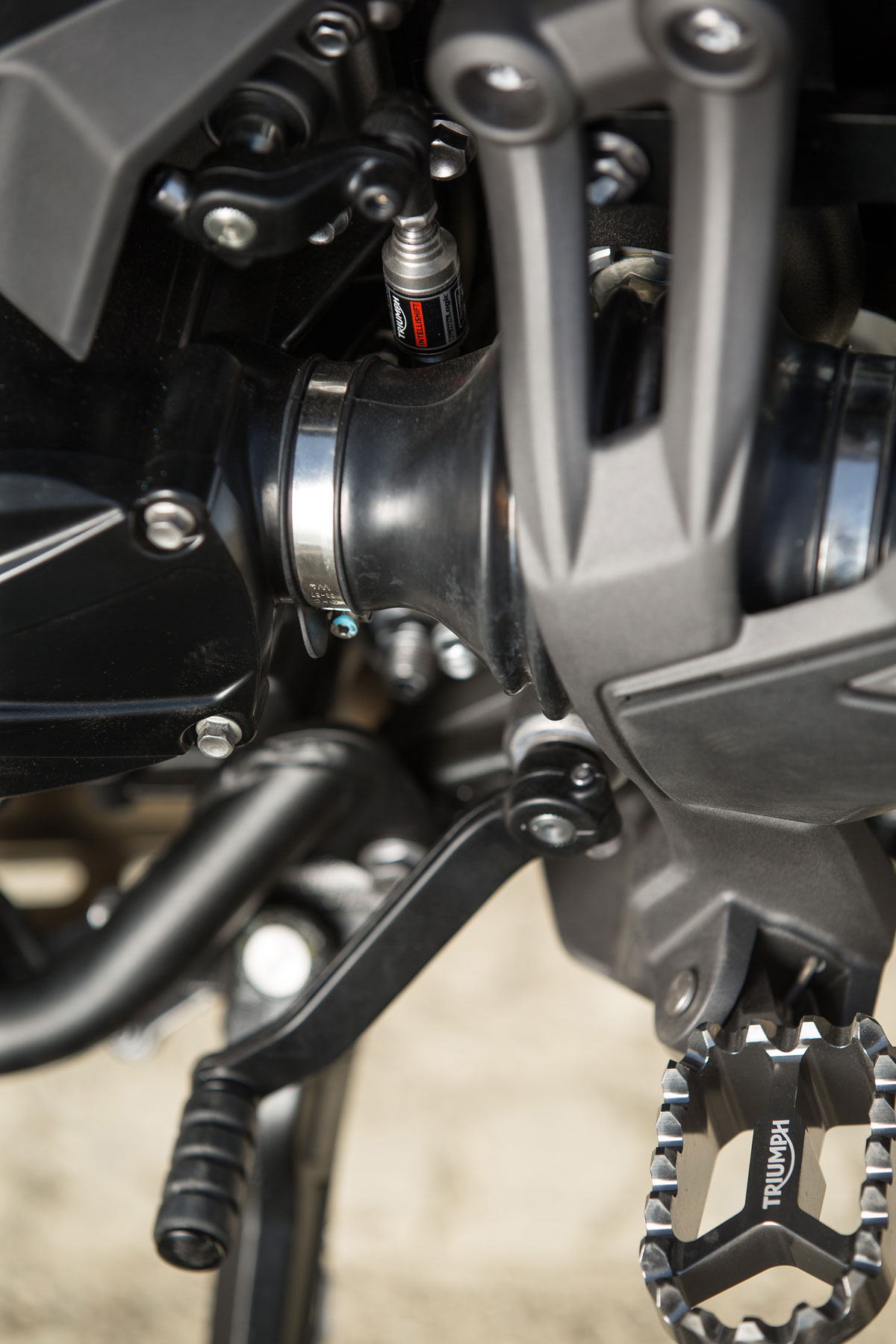 These days, 16 to 21 thousand dollars will get you a bike with some brains and the new Tiger 1200 just got a lot more cerebral. Perhaps the biggest change this year is in the electronic wizardry which ties all the systems together. Many of Triumph's chief engineers were on hand at the press launch to answer questions. Traction Control, power delivery, braking and even shifting now runs through a complex network of sensors and computers which adjust to rider, bike and road demands. Although there's enough electronics on the new Tiger 1200 to give a Luddite a heart attack, at least the Tire Pressure Monitoring System (TPMS) is omitted from the hefty list of features.
These days, 16 to 21 thousand dollars will get you a bike with some brains and the new Tiger 1200 just got a lot more cerebral. Perhaps the biggest change this year is in the electronic wizardry which ties all the systems together. Many of Triumph's chief engineers were on hand at the press launch to answer questions. Traction Control, power delivery, braking and even shifting now runs through a complex network of sensors and computers which adjust to rider, bike and road demands. Although there's enough electronics on the new Tiger 1200 to give a Luddite a heart attack, at least the Tire Pressure Monitoring System (TPMS) is omitted from the hefty list of features.
2018 introduces a new clutchless shifting system which works well but takes some getting used to. A pressure sensor attached to the shift lever tells the onboard computer when to release pressure on the gears, match the engine speed to the desired target gear ratio, then drop it into the next gear. Since the electronics does this for you in a fraction of a second, it's better to keep the throttle consistent and let the computer do the calculations for smooth, positive, and clutch-less shifts. The clutch lever itself still works great and has a very light pull, but it's nice to have this option available especially when standing.
Triumph is also proud to announce they managed to shave around 20lbs of weight from the 2018 model. Most of the weight was taken from various bits of the bike including the crankcase, magnesium cam covers, skid plate, engine guards and a shorter exhaust, which gets a titanium Arrow muffler on premium versions.
Although it's still relatively more top heavy than a BMW 1200GS boxer motor would be, the new Tiger's combined traction control, suspension and braking electronics make for an unusually flickable ride with both torque and top end power delivery that needs to be experienced. Mated to all the sensor magic, it's never been easier to grab a handful of throttle in a corner and not worry as much about losing the rear wheel.
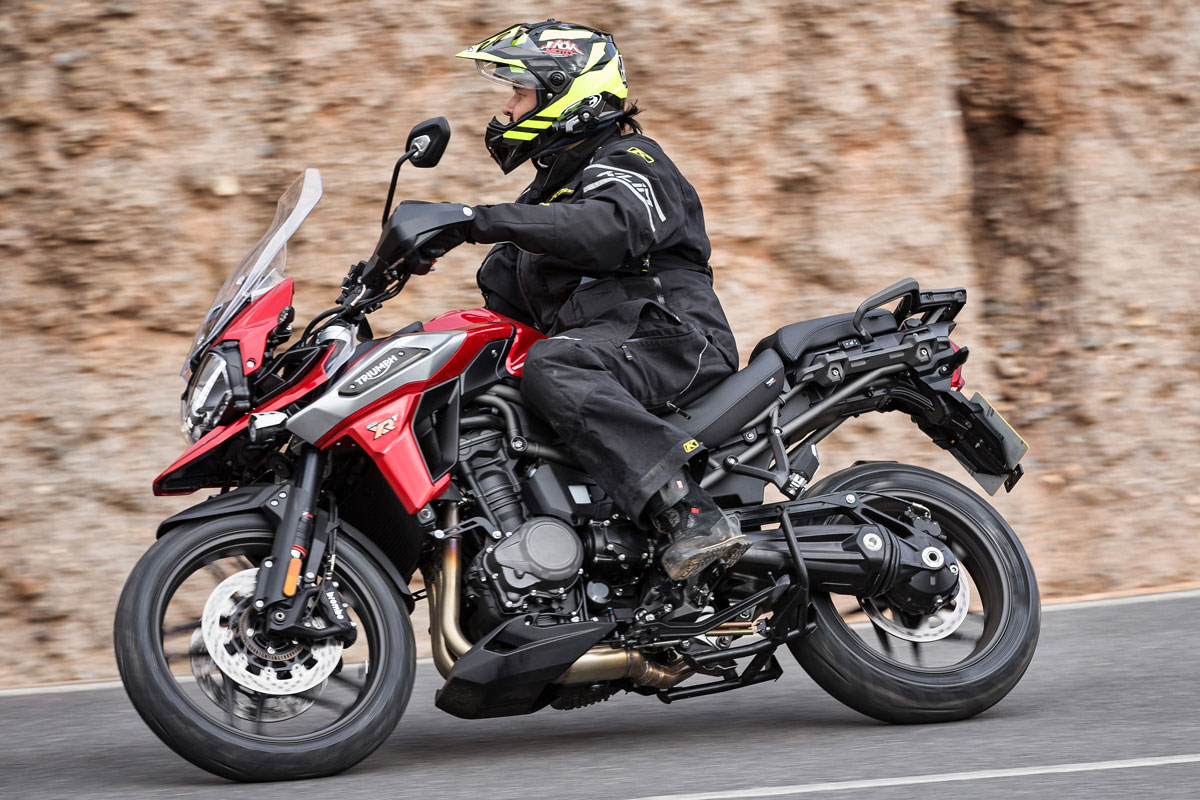
• SUSPENSION, BRAKING and HANDLING
For a big cat to run through any jungle, be it urban or rural, its legs have to be up to the task. From paved twisties to gravelly back roads, the new Tiger 1200 moves like never before. Triumph’s wizards performed their magic to bolster the new Tiger's handling, safety and suspension. The new WP shocks are better tuned than the previous model, but Triumph's Semi-Active Suspension (TSAS) system diversifies the big bike's capabilities both on and off-road. The bike feels "fully-active", utilizing a set of sensors to detect a host of data from wheel travel, lean angle to available traction. This data is used by the computer system to adjust the suspension, brakes, and power output in various ways to improve your ride.
One trick to optimizing traction control is to keep the rear tire firmly on the ground for the maximum amount of time possible. Although the changes happen in milliseconds, TSAS can adjust the shock's rebound rate on the fly to make sure you're rear tire is where it needs to be. Not only that, the system is predictive as well. Front wheel sensors record behavior which is then used to tell the rear wheel what it may expect and again help it adjust accordingly. Add in smart ABS traction control, and you have an almost artificially inspired ride.
On paved twisties the electronics work flawlessly, but take some getting used to. The computer helps limit what could be a rider induced ham-fisted catastrophic decision. The XRt’s we tested were equipped with Metzler Tourance Next tires which did extremely well in warm, cool, dry and wet conditions, inspiring confidence.
Now let's be clear, any computer system will not allow you, or the bike, to defy the laws of physics. All standard safe riding procedure must still be observed, but in this case, Triumph's touch-of-technology can make your ride a little more fun and safer to boot.
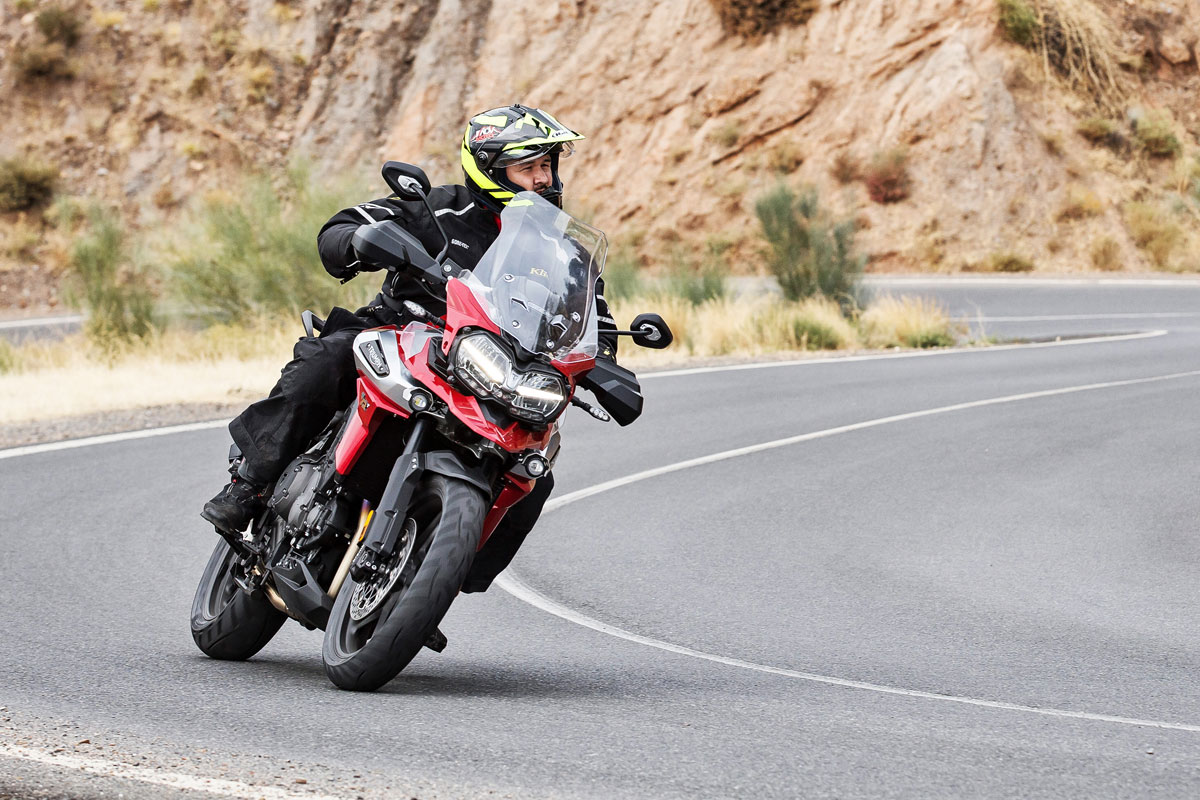
While a lot of the Tiger 1200's handling prowess is computer managed, there's still plenty of settings we can control manually. Five primary traction control modes come standard on all mid to top level models (Road, Rain, Off-Road, Sport and Off). XC's come with a sixth "Off-Road Pro" mode with no ABS or Traction Control and is a pretty unhinged experience sure to be appreciated by more aggressive dirt riders. For most mere mortals who will take the Tiger beyond pavement, the "Off-Road" mode works great, disabling the rear ABS and limiting (but not fully eliminating) traction control.
Suspension stiffness can be set from “Comfort” to “Sport” on the fly using the handy left thumb command joystick. Playing with the settings creates a noticeable difference in the suspension's compliance which can be tuned for just about any situation you'd put a motorcycle through.
Most of our off-road testing was done in hard packed sand with the occasional rut or light rocky sections you’d find in the American South West. Our off-road XCa's sported optional Pirelli Scorpion Rallys which were perfect off-road, but naturally a bit buzzy on pavement.
Most of the testers complimented the Tiger 1200 for its performance on loose sand or dirt and everyone came away safely with smiles on their faces. At 200lbs, for me the bike never bottomed-out and the only drawback of the design is that it's still top-heavy by nature. Taking the Tiger 1200 for what it is (not a 250lb pound dirt bike) the collective improvements are nothing short of amazing.
At Triumph’s press junket, the Dakar racers who contributed to the bike's development showcased what the Tiger 1200 is capable of in the right hands. The triple-cylinder monster’s howl echoed in the mountains, leaving clouds of dusts through beautifully composed power-slides. There's zero doubt the new bike is a much more capable off-road machine than ever before. We only hope some of these overall improvements make it to the new Tiger 800!
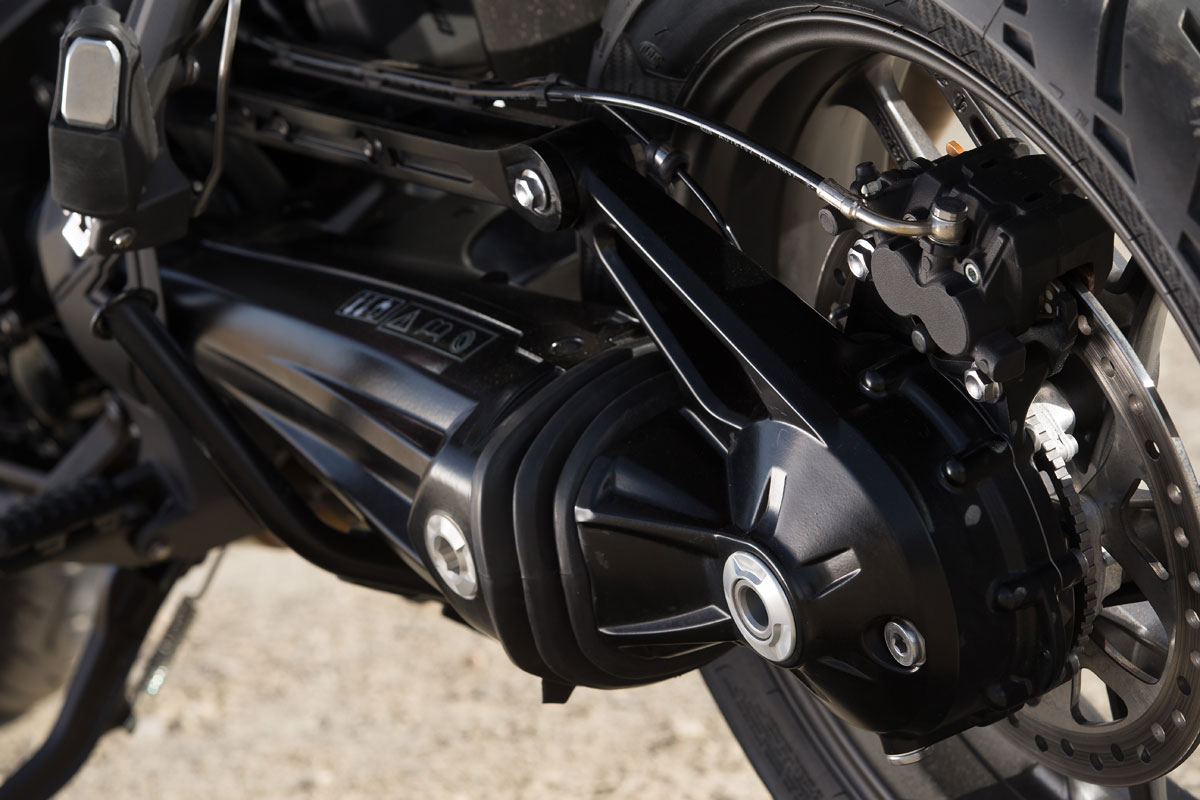
• COMFORT and ERGONOMICS
Many bikes are comfortable only in a seated position or standing, but not both. Triumph tackled this common problem in a few key areas and has provided the new Tiger 1200 with one of the most comfortable ergonomics around.
A 20mm greater bar pull back with a fairly deep sweep proved to be ideal either standing or sitting for every test rider. During the off-road portion of the test on XCa models, at 6 feet tall the only change I’d make would be a very slight bar rise or even just a slight rotation of the bar. Those who are over 6' 2" or so may want to add a 1 inch of bar height, but geometry changes will be unnecessary for most riders. A unique bar shape may make fitting more robust handguards problematic but there's no way to tell without actually trying. The plastic handguards are one of the first, and few, pieces to change on the new Tiger 1200, if you're taking it into the wilds.
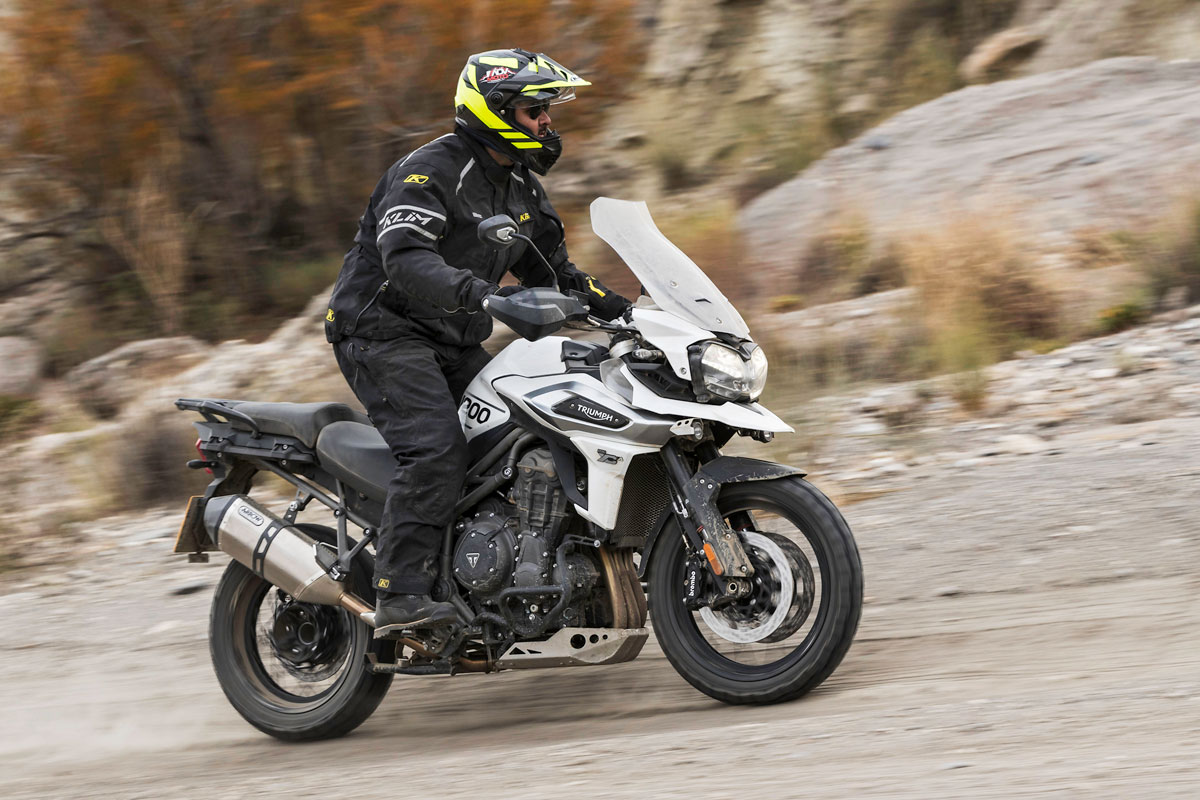
The XCa's metal footpegs are just wide, long and firm enough to provide a stable platform for heavier boots, without reducing lean angle or shifter clearance. They’re also nice and low for a roomy seating position and easy standing, but be careful about boot scraping on turns! Although the bike looks narrower than the previous model, the 5.2 gallon tank remains the same width despite new body lines.
No one complained about a sore tush after two days of riding which is a testament to the stock saddle's comfort. Even nicer is the heated front and rear seat options. The rear seat actually has a separate control switch so passengers can activate it themselves. Superbly integrated heated grip switch on the left grip fortunately takes up little room, leaving space for more controls.
A new fairing shape does a wonderful job of keeping the ride a non-fatiguing experience while an electronically adjustable screen goes a long way in customizing the air flow over your shoulders and helmet. Although a taller screen is available as an option, the smaller screen will work fine for most people.
We are happy to see a Low Ride Height (LRH) version in the XR line, which includes a lower saddle but also a lowered suspension. All Tigers now have over one inch of seat adjustment built in, but the added changes to the Tiger 1200 XRx LRH model bring the seat height to a manageable 31 inches. That is the lowest seat height in this class.
• FEATURES and CONTROLS
The hardest new update to miss visually in the much welcome 5 inch TFT display. The original 1200 Explorer had a rather confusing display with handlebar control switches we found frustrating and distracting to use. With the updated system, managing the myriad of settings is more simplified and logical; which means less distracting and safer.
Replacing the fidgety buttons found on the previous model, most of the work has been relegated to a five-axis joystick just below the turn signals on the left side switch box. Even better, the switch boxes are now backlit in amber for easy visibility without affecting your night vision.
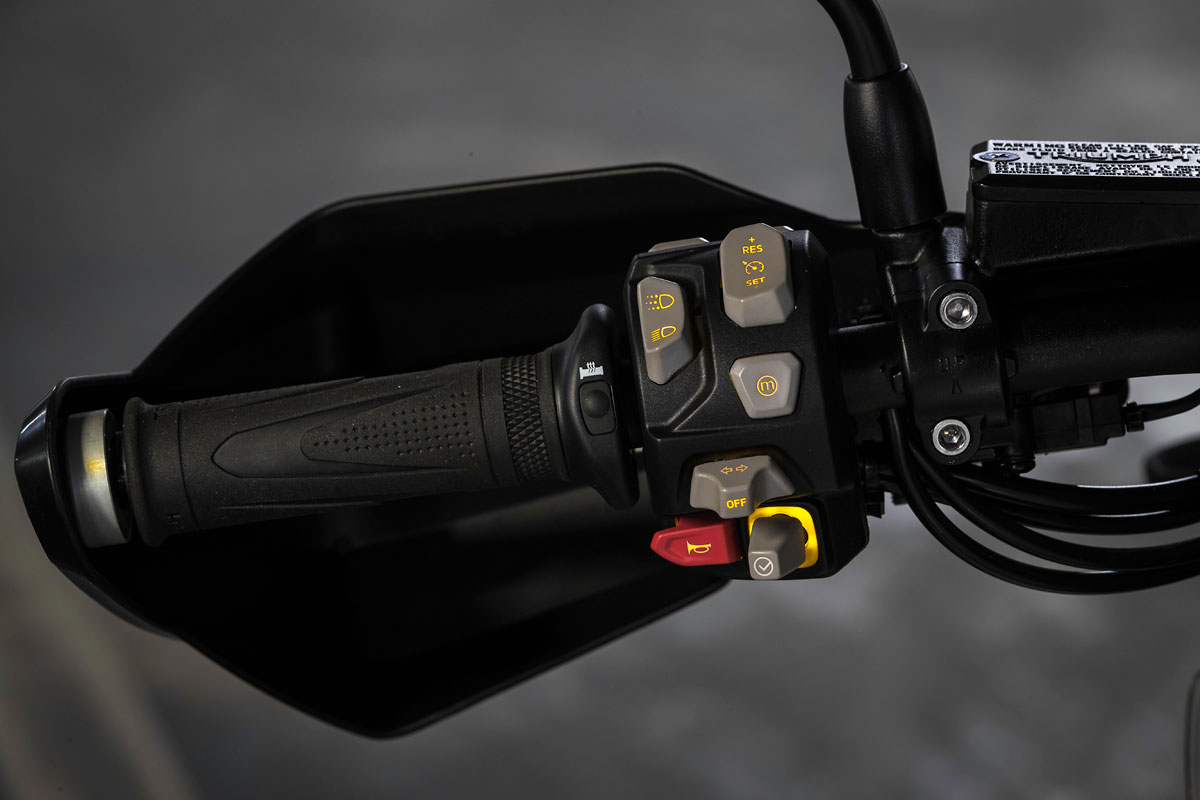
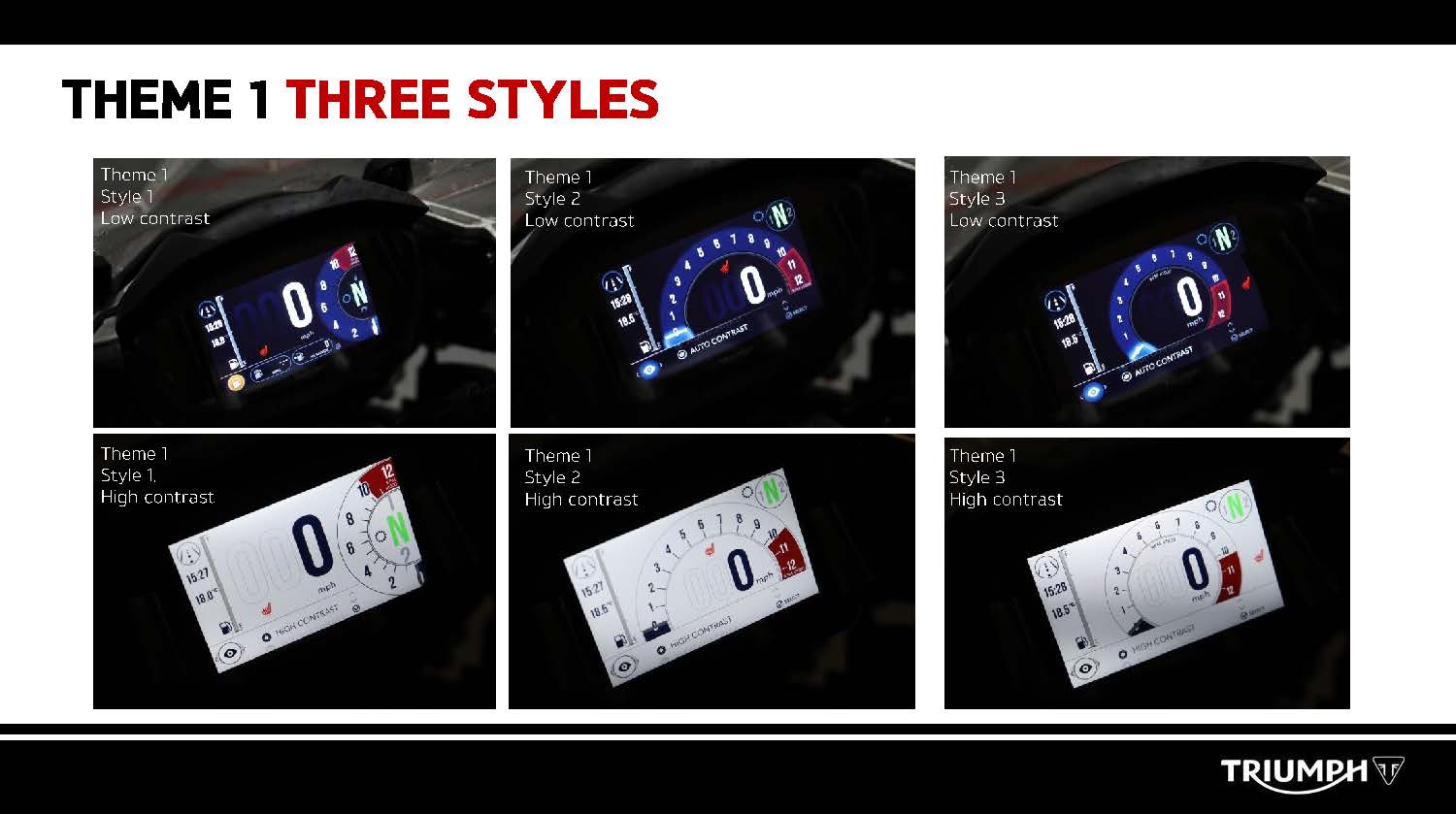
One of the most critical features is the five or six ride modes mentioned above. Being able to alter so many aspects of your bike's performance on-the-go using just a thumb is impressive. You can select your ride mode selection with a dedicated button just above the turn signals, and tapping left or right on the joystick can make your ride softer or firmer in roughly 16 increments.
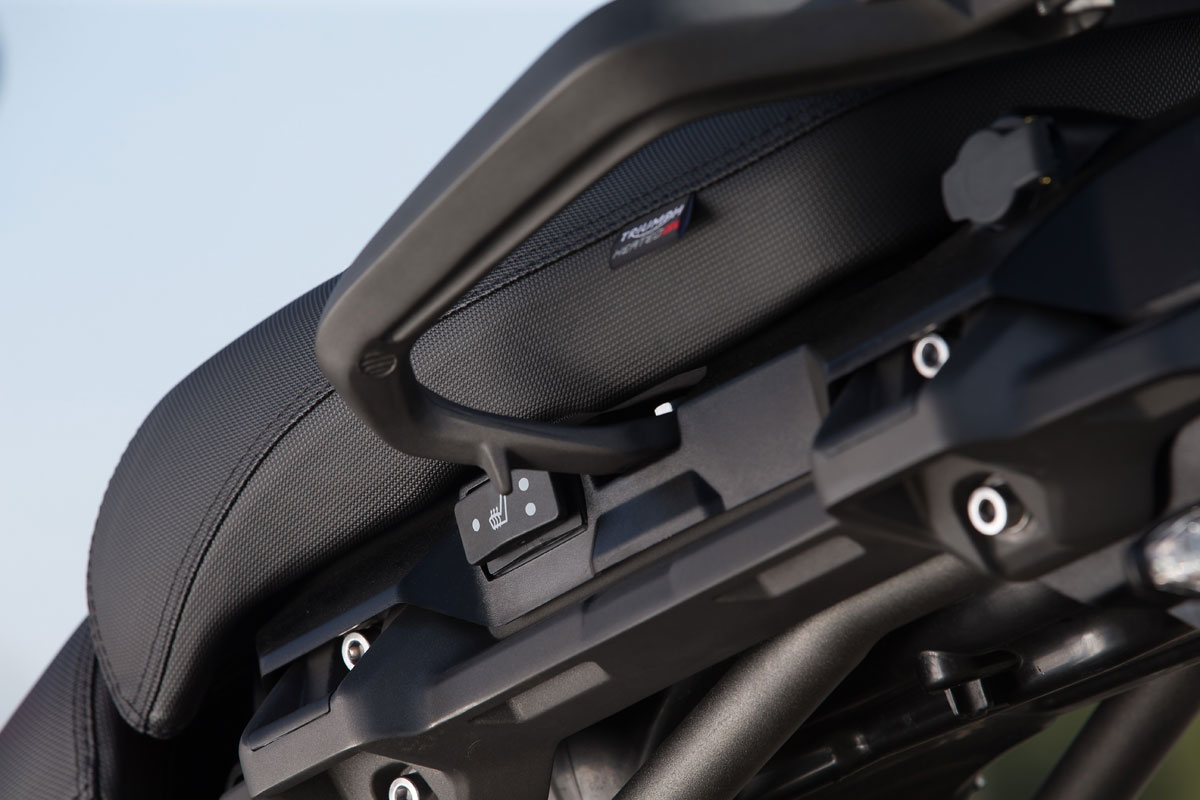 The angle adjustable instrument readout is quick, bright and visible even during the middle of the day, with plenty of information at your fingertips. You can even change the layout and theme of the screen in three (or six on top models) styles with both high and low contrast versions. This feature is something we hope to see become more common and affordable on bikes in general.
The angle adjustable instrument readout is quick, bright and visible even during the middle of the day, with plenty of information at your fingertips. You can even change the layout and theme of the screen in three (or six on top models) styles with both high and low contrast versions. This feature is something we hope to see become more common and affordable on bikes in general.
Everything from your heated grip levels to trip computers and more are all nicely organized and easy to read at a glance. Even over the relatively short amount of time we had on the bikes during the launch, it didn't take much to get used to both the screen and controls. Yet another major and welcome improvement to the new cat!
There are more models, changes and improvements to the new Tiger 1200 than most anyone would want to read in one article. For full details, charts and specs beyond the scope of what's discussed here, feel free to download the new Tiger's 82 page Specifications PDF highlighting many of the key points on this fresh new release.
• SUMMARY
The bikes performed near flawlessly during our testing and left a few of us scratching heads for serious problems. Despite its slightly lighter weight, it’s still relatively top-heavy and the OEM plastic hand guards would be the first thing to go in a crash. This level of hair-splitting though seems nearly irrelevant to what is a greatly improved, highly capable all-round package with a price tag to match.
Relative to other bikes on the market, Triumph's 2018 Tiger 1200 has taken a great leap into the off-road capable world, while upping rider comfort, safety and on-road prowess. The smooth powerful motor is an exhilarating experience and may be the best bike in its class for sport-touring. The LRH model's low seat height might make the Tiger 1200 the most sensible big ADV bike for shorter riders. We welcome the more dirt-road friendly DNA for 2018 and are amazed at how much electronics can help stabilize a bike of this size in a wide range of conditions.
More than just new stripes, the myriad of improvements to applied technology, power delivery, comfort, suspension and safety combine to make Triumph's 2018 Tiger 1200 a ferociously versatile leader in it's class. Previous generation owners will want to check out the changes as well. There's never been a better time to grab this Tiger by the tail and go for a spin!
For more information, download Triumph's Tiger 1200 Specifications PDF here or visit Triumph's official website here.
Despite the 2018 Tiger 1200's improved dirt capabilities, we always suggest new off-road riders learn their skills on much smaller bikes...even if coming from large street bikes. Once you get more confidence in limited traction environments, then pushing a highly capable bike like this will be both safer and more fun.
Speaking of which, Triumph's new Global Adventure Training Academy has been cooking over the past two years and will be looking to get butts in saddles for 2018. Stay tuned for more news on this soon!
Special thanks to Triumph Motorcycles and Kingdom Creative for the images, video clips and good work in Almeria, Spain.
• 2018 Tiger 1200 Specifications
• Engine and Transmission
Type: Liquid-cooled, 12 valve DOHC, in-line 3-cylinder
Capacity: 1,215cc
Compression: 11.0:1
Max Power: 139bhp @ 9,350rpm
Max Torque: 90ft-lbs.
System: Ride by Wire, fuel injection
Final Drive: Shaft Drive
Clutch: Wet, multi-plate hydraulically operated, torque assist
Gearbox: 6-Speed
• Chassis
Frame: Tubular Steel Trellis
Swingarm: Single-sided, Cast Aluminium Alloy with Shaft Drive
Front Wheels: Cast aluminum alloy 10-spoke 19 x 3.0 in
Rear Wheels: Cast aluminum alloy 10-spoke 17 x 4.5 in
Front Suspension: WP 48 mm upside-down forks, electronically adjustable damping, 190 mm travel (168 mm low seat version)
Rear Suspension: WP monoshock, electronically adjustable semi-active damping with automatic preload adjustment, 193 mm wheel travel (158 mm low seat version)
Front Brakes: Twin 305 mm floating discs, radially mounted monobloc Brembo 4-piston calipers, switchable ABS
Rear Brakes: Single 282 mm disc, Nissin 2-piston sliding caliper, switchable ABS
Instrument Display and Functions: TFT multifunctional instrument pack with digital speedometer, trip computer, digital tachometer, gear position indicator, fuel gauge, service indicator, ambient temperature, clock and 4 rider modes (Road/Offroad/Sport/Rain).
• Dimensions and Weights
Width Handlebars: 830 mm
Height Without Mirror: 1,470 mm
Seat Height: 835 - 855 mm. Low seat version available: 815 - 835 mm
Wheelbase: 1,520 mm
Rake 23.2 degrees
Trail: 99.9 mm
Dry Weight: 538lbs
Tank Capacity: 5.28 gal.
• Fuel Consuption
Fuel Consuption: 54.3 MPG
• Pricing - MSRP in USD
Tiger 1200 XR - $16,500
Tiger 1200 XRx - $18,750
Tiger 1200 XRx Low - $18,750
Tiger 1200 XCx - $19,550
Tiger 1200 XCa - $21,750
{gallery}ARTICLES/Bikes/Triumph/2018-Tiger1200/gallery{/gallery}
Read more ...

Having shed the Explorer moniker, Triumph ushers in a new era for their flagship adventure bike with the 2018 Tiger 1200. Changing a name, like simply updating graphics or colors, can mean anything. Visual updates aside, does this big Tiger have more bite or just new stripes? ADVMoto travels to beautiful Almeria, Spain to find out.
https://www.youtube.com/watch?v=6ou-4dkxDn0
• Power and Performance
Power is almost never a problem when it comes to modern 1200cc class bikes. Although they tend to be heavy, there's plenty of torque on hand to get you out of most low speed situations and cruise comfortably at highway speeds. The big difference isn't only the sheer power, but how it's managed and delivered.
Triumph made several updates to the three-cylinder power plant which saw a slight increase to 141hp near its 10,000RPM redline. With 90ft-lbs (at 7,600RPM) on tap, the 1,215 triple moves the claimed 546lbs dry weight well enough, especially when you get the motor singing at the top end of its nearly linear horse power delivery.

One rider said throttle response almost felt like well-tuned carburation, and I agree. There wasn't the "on-off" feeling of the power which is associated with even the best FI models and what's more amazing is how well this worked in low speed conditions for both on and off-road. There wasn't even any slop in the shaft drive which felt unusually tight and contributed to the Tiger's predictable manners.
From around 2,000 RPM the Tiger 1200 can pull you out of some tight spots without lugging, even if you're in a gear too high. It wasn't clear if this was due to another bit of electronic wizardry or simply a function of the large three-cylinder engine, but it worked well and made the big beast very manageable.

2018 introduces a new clutchless shifting system which works well but takes some getting used to. A pressure sensor attached to the shift lever tells the onboard computer when to release pressure on the gears, match the engine speed to the desired target gear ratio, then drop it into the next gear. Since the electronics does this for you in a fraction of a second, it's better to keep the throttle consistent and let the computer do the calculations for smooth, positive, and clutch-less shifts. The clutch lever itself still works great and has a very light pull, but it's nice to have this option available especially when standing.
Triumph is also proud to announce they managed to shave around 20lbs of weight from the 2018 model. Most of the weight was taken from various bits of the bike including the crankcase, magnesium cam covers, skid plate, engine guards and a shorter exhaust, which gets a titanium Arrow muffler on premium versions.
Although it's still relatively more top heavy than a BMW 1200GS boxer motor would be, the new Tiger's combined traction control, suspension and braking electronics make for an unusually flickable ride with both torque and top end power delivery that needs to be experienced. Mated to all the sensor magic, it's never been easier to grab a handful of throttle in a corner and not worry as much about losing the rear wheel.

• SUSPENSION, BRAKING and HANDLING
For a big cat to run through any jungle, be it urban or rural, its legs have to be up to the task. From paved twisties to gravelly back roads, the new Tiger 1200 moves like never before. Triumph’s wizards performed their magic to bolster the new Tiger's handling, safety and suspension. The new WP shocks are better tuned than the previous model, but Triumph's Semi-Active Suspension (TSAS) system diversifies the big bike's capabilities both on and off-road. The bike feels "fully-active", utilizing a set of sensors to detect a host of data from wheel travel, lean angle to available traction. This data is used by the computer system to adjust the suspension, brakes, and power output in various ways to improve your ride.
One trick to optimizing traction control is to keep the rear tire firmly on the ground for the maximum amount of time possible. Although the changes happen in milliseconds, TSAS can adjust the shock's rebound rate on the fly to make sure you're rear tire is where it needs to be. Not only that, the system is predictive as well. Front wheel sensors record behavior which is then used to tell the rear wheel what it may expect and again help it adjust accordingly. Add in smart ABS traction control, and you have an almost artificially inspired ride.
On paved twisties the electronics work flawlessly, but take some getting used to. The computer helps limit what could be a rider induced ham-fisted catastrophic decision. The XRt’s we tested were equipped with Metzler Tourance Next tires which did extremely well in warm, cool, dry and wet conditions, inspiring confidence.
Now let's be clear, any computer system will not allow you, or the bike, to defy the laws of physics. All standard safe riding procedure must still be observed, but in this case, Triumph's touch-of-technology can make your ride a little more fun and safer to boot.

While a lot of the Tiger 1200's handling prowess is computer managed, there's still plenty of settings we can control manually. Five primary traction control modes come standard on all mid to top level models (Road, Rain, Off-Road, Sport and Off). XC's come with a sixth "Off-Road Pro" mode with no ABS or Traction Control and is a pretty unhinged experience sure to be appreciated by more aggressive dirt riders. For most mere mortals who will take the Tiger beyond pavement, the "Off-Road" mode works great, disabling the rear ABS and limiting (but not fully eliminating) traction control.
Suspension stiffness can be set from “Comfort” to “Sport” on the fly using the handy left thumb command joystick. Playing with the settings creates a noticeable difference in the suspension's compliance which can be tuned for just about any situation you'd put a motorcycle through.
Most of our off-road testing was done in hard packed sand with the occasional rut or light rocky sections you’d find in the American South West. Our off-road XCa's sported optional Pirelli Scorpion Rallys which were perfect off-road, but naturally a bit buzzy on pavement.
Most of the testers complimented the Tiger 1200 for its performance on loose sand or dirt and everyone came away safely with smiles on their faces. At 200lbs, for me the bike never bottomed-out and the only drawback of the design is that it's still top-heavy by nature. Taking the Tiger 1200 for what it is (not a 250lb pound dirt bike) the collective improvements are nothing short of amazing.
At Triumph’s press junket, the Dakar racers who contributed to the bike's development showcased what the Tiger 1200 is capable of in the right hands. The triple-cylinder monster’s howl echoed in the mountains, leaving clouds of dusts through beautifully composed power-slides. There's zero doubt the new bike is a much more capable off-road machine than ever before. We only hope some of these overall improvements make it to the new Tiger 800!

• COMFORT and ERGONOMICS
Many bikes are comfortable only in a seated position or standing, but not both. Triumph tackled this common problem in a few key areas and has provided the new Tiger 1200 with one of the most comfortable ergonomics around.
A 20mm greater bar pull back with a fairly deep sweep proved to be ideal either standing or sitting for every test rider. During the off-road portion of the test on XCa models, at 6 feet tall the only change I’d make would be a very slight bar rise or even just a slight rotation of the bar. Those who are over 6' 2" or so may want to add a 1 inch of bar height, but geometry changes will be unnecessary for most riders. A unique bar shape may make fitting more robust handguards problematic but there's no way to tell without actually trying. The plastic handguards are one of the first, and few, pieces to change on the new Tiger 1200, if you're taking it into the wilds.

The XCa's metal footpegs are just wide, long and firm enough to provide a stable platform for heavier boots, without reducing lean angle or shifter clearance. They’re also nice and low for a roomy seating position and easy standing, but be careful about boot scraping on turns! Although the bike looks narrower than the previous model, the 5.2 gallon tank remains the same width despite new body lines.
No one complained about a sore tush after two days of riding which is a testament to the stock saddle's comfort. Even nicer is the heated front and rear seat options. The rear seat actually has a separate control switch so passengers can activate it themselves. Superbly integrated heated grip switch on the left grip fortunately takes up little room, leaving space for more controls.
A new fairing shape does a wonderful job of keeping the ride a non-fatiguing experience while an electronically adjustable screen goes a long way in customizing the air flow over your shoulders and helmet. Although a taller screen is available as an option, the smaller screen will work fine for most people.
We are happy to see a Low Ride Height (LRH) version in the XR line, which includes a lower saddle but also a lowered suspension. All Tigers now have over one inch of seat adjustment built in, but the added changes to the Tiger 1200 XRx LRH model bring the seat height to a manageable 31 inches. That is the lowest seat height in this class.
• FEATURES and CONTROLS
The hardest new update to miss visually in the much welcome 5 inch TFT display. The original 1200 Explorer had a rather confusing display with handlebar control switches we found frustrating and distracting to use. With the updated system, managing the myriad of settings is more simplified and logical; which means less distracting and safer.
Replacing the fidgety buttons found on the previous model, most of the work has been relegated to a five-axis joystick just below the turn signals on the left side switch box. Even better, the switch boxes are now backlit in amber for easy visibility without affecting your night vision.


One of the most critical features is the five or six ride modes mentioned above. Being able to alter so many aspects of your bike's performance on-the-go using just a thumb is impressive. You can select your ride mode selection with a dedicated button just above the turn signals, and tapping left or right on the joystick can make your ride softer or firmer in roughly 16 increments.

Everything from your heated grip levels to trip computers and more are all nicely organized and easy to read at a glance. Even over the relatively short amount of time we had on the bikes during the launch, it didn't take much to get used to both the screen and controls. Yet another major and welcome improvement to the new cat!
There are more models, changes and improvements to the new Tiger 1200 than most anyone would want to read in one article. For full details, charts and specs beyond the scope of what's discussed here, feel free to download the new Tiger's 82 page Specifications PDF highlighting many of the key points on this fresh new release.
• SUMMARY
The bikes performed near flawlessly during our testing and left a few of us scratching heads for serious problems. Despite its slightly lighter weight, it’s still relatively top-heavy and the OEM plastic hand guards would be the first thing to go in a crash. This level of hair-splitting though seems nearly irrelevant to what is a greatly improved, highly capable all-round package with a price tag to match.
Relative to other bikes on the market, Triumph's 2018 Tiger 1200 has taken a great leap into the off-road capable world, while upping rider comfort, safety and on-road prowess. The smooth powerful motor is an exhilarating experience and may be the best bike in its class for sport-touring. The LRH model's low seat height might make the Tiger 1200 the most sensible big ADV bike for shorter riders. We welcome the more dirt-road friendly DNA for 2018 and are amazed at how much electronics can help stabilize a bike of this size in a wide range of conditions.
More than just new stripes, the myriad of improvements to applied technology, power delivery, comfort, suspension and safety combine to make Triumph's 2018 Tiger 1200 a ferociously versatile leader in it's class. Previous generation owners will want to check out the changes as well. There's never been a better time to grab this Tiger by the tail and go for a spin!
For more information, download Triumph's Tiger 1200 Specifications PDF here or visit Triumph's official website here.
Despite the 2018 Tiger 1200's improved dirt capabilities, we always suggest new off-road riders learn their skills on much smaller bikes...even if coming from large street bikes. Once you get more confidence in limited traction environments, then pushing a highly capable bike like this will be both safer and more fun.
Speaking of which, Triumph's new Global Adventure Training Academy has been cooking over the past two years and will be looking to get butts in saddles for 2018. Stay tuned for more news on this soon!
Special thanks to Triumph Motorcycles and Kingdom Creative for the images, video clips and good work in Almeria, Spain.
• 2018 Tiger 1200 Specifications
• Engine and Transmission
Type: Liquid-cooled, 12 valve DOHC, in-line 3-cylinder
Capacity: 1,215cc
Compression: 11.0:1
Max Power: 139bhp @ 9,350rpm
Max Torque: 90ft-lbs.
System: Ride by Wire, fuel injection
Final Drive: Shaft Drive
Clutch: Wet, multi-plate hydraulically operated, torque assist
Gearbox: 6-Speed
• Chassis
Frame: Tubular Steel Trellis
Swingarm: Single-sided, Cast Aluminium Alloy with Shaft Drive
Front Wheels: Cast aluminum alloy 10-spoke 19 x 3.0 in
Rear Wheels: Cast aluminum alloy 10-spoke 17 x 4.5 in
Front Suspension: WP 48 mm upside-down forks, electronically adjustable damping, 190 mm travel (168 mm low seat version)
Rear Suspension: WP monoshock, electronically adjustable semi-active damping with automatic preload adjustment, 193 mm wheel travel (158 mm low seat version)
Front Brakes: Twin 305 mm floating discs, radially mounted monobloc Brembo 4-piston calipers, switchable ABS
Rear Brakes: Single 282 mm disc, Nissin 2-piston sliding caliper, switchable ABS
Instrument Display and Functions: TFT multifunctional instrument pack with digital speedometer, trip computer, digital tachometer, gear position indicator, fuel gauge, service indicator, ambient temperature, clock and 4 rider modes (Road/Offroad/Sport/Rain).
• Dimensions and Weights
Width Handlebars: 830 mm
Height Without Mirror: 1,470 mm
Seat Height: 835 - 855 mm. Low seat version available: 815 - 835 mm
Wheelbase: 1,520 mm
Rake 23.2 degrees
Trail: 99.9 mm
Dry Weight: 538lbs
Tank Capacity: 5.28 gal.
• Fuel Consuption
Fuel Consuption: 54.3 MPG
• Pricing - MSRP in USD
Tiger 1200 XR - $16,500
Tiger 1200 XRx - $18,750
Tiger 1200 XRx Low - $18,750
Tiger 1200 XCx - $19,550
Tiger 1200 XCa - $21,750
{gallery}ARTICLES/Bikes/Triumph/2018-Tiger1200/gallery{/gallery}
Read more ...

 you must live here too.
you must live here too.